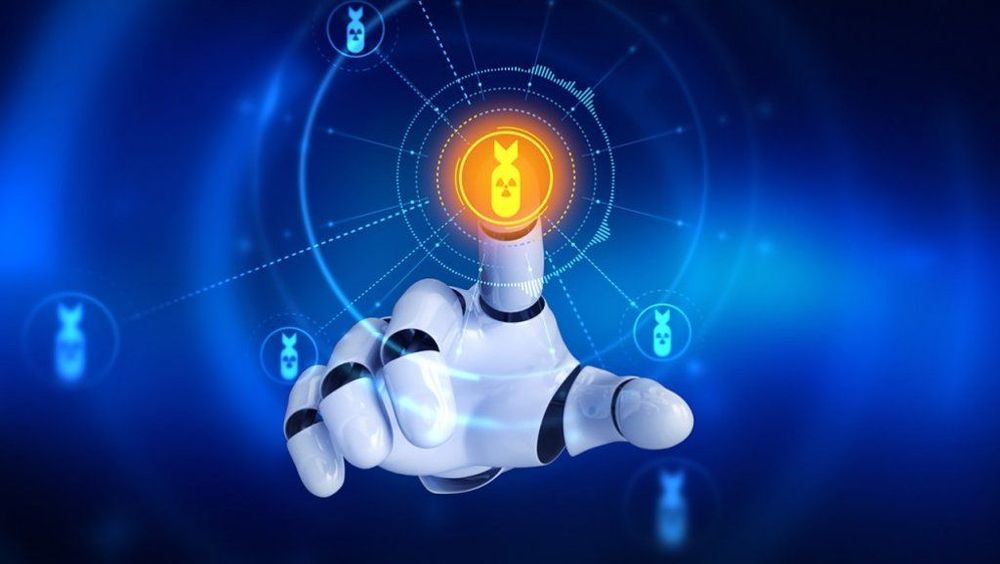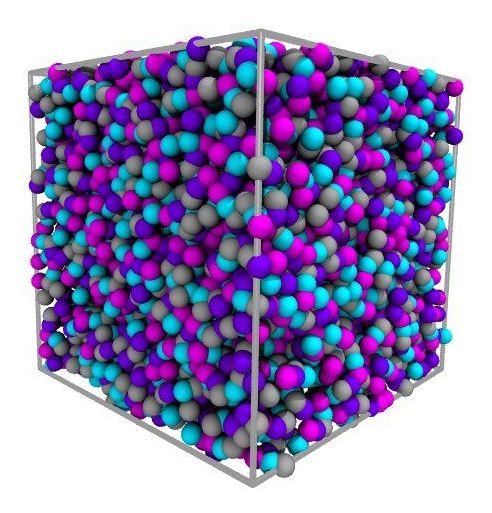Archive for the ‘information science’ category: Page 243
May 9, 2019
Designer Julia Daviy Introduces Her Digitally Customizable 3D Printed Skirt
Posted by Quinn Sena in categories: 3D printing, education, energy, information science, sustainability
 3D printing is moving ever closer to gaining a true home in mainstream commercial applications, thanks to the impact the technology is having on consumer fashion products such as jewelry, footwear, and clothing. While 3D printed fashion was still considered to be more of a novelty a few years ago, efforts have been increasing to make it more common – even in the classroom. Additionally, the technology is helping to usher in a more sustainable and eco-friendly way of manufacturing garments…and designer Julia Daviy is helping to lead the charge.
3D printing is moving ever closer to gaining a true home in mainstream commercial applications, thanks to the impact the technology is having on consumer fashion products such as jewelry, footwear, and clothing. While 3D printed fashion was still considered to be more of a novelty a few years ago, efforts have been increasing to make it more common – even in the classroom. Additionally, the technology is helping to usher in a more sustainable and eco-friendly way of manufacturing garments…and designer Julia Daviy is helping to lead the charge.
In addition to designing clothes, Daviy is also an ecologist and clean technology industry manager, and uses 3D printing to make cruelty-free, zero-waste clothing. She believes that the technology will change how the world produces clothing, especially when it comes to some of the more problematic issues of garment manufacturing, such as animal exploitation, chemical pollution, energy consumption, and material waste.
“Our goal was never to demonstrate the viability of 3D printed clothing and leave things at that. We’ll have succeeded when beautiful, comfortable, ethically manufactured and environmentally friendly clothes are the standard,” Daviy stated. “The innovations we’ve made on the production and marketing side of the equation are just as important as the technological breakthroughs that have gotten us this far.”
Continue reading “Designer Julia Daviy Introduces Her Digitally Customizable 3D Printed Skirt” »
May 8, 2019
Wireless movement-tracking system could collect health and behavioral data
Posted by Quinn Sena in categories: health, information science
We live in a world of wireless signals flowing around us and bouncing off our bodies. MIT researchers are now leveraging those signal reflections to provide scientists and caregivers with valuable insights into people’s behavior and health.
The system, called Marko, transmits a low-power radio-frequency (RF) signal into an environment. The signal will return to the system with certain changes if it has bounced off a moving human. Novel algorithms then analyze those changed reflections and associate them with specific individuals.
The system then traces each individual’s movement around a digital floor plan. Matching these movement patterns with other data can provide insights about how people interact with each other and the environment.
Continue reading “Wireless movement-tracking system could collect health and behavioral data” »
May 6, 2019
AI can detect depression in a child’s speech
Posted by Quinn Sena in categories: biotech/medical, health, information science, robotics/AI
A machine learning algorithm can detect signs of anxiety and depression in the speech patterns of young children, potentially providing a fast and easy way of diagnosing conditions that are difficult to spot and often overlooked in young people, according to new research published in the Journal of Biomedical and Health Informatics.
Around one in five children suffer from anxiety and depression, collectively known as “internalizing disorders.” But because children under the age of eight can’t reliably articulate their emotional suffering, adults need to be able to infer their mental state, and recognise potential mental health problems. Waiting lists for appointments with psychologists, insurance issues, and failure to recognise the symptoms by parents all contribute to children missing out on vital treatment.
“We need quick, objective tests to catch kids when they are suffering,” says Ellen McGinnis, a clinical psychologist at the University of Vermont Medical Center’s Vermont Center for Children, Youth and Families and lead author of the study. “The majority of kids under eight are undiagnosed.”
Continue reading “AI can detect depression in a child’s speech” »
May 6, 2019
Algorithms help spot cancer ‘lottery winners’ in new Fred Hutch study
Posted by Genevieve Klien in categories: biotech/medical, information science, robotics/AI
For most patients, a diagnosis of stage 4 non-small cell lung cancer comes with a dire prognosis. But for patients with specific mutations that cause the disease, there are potentially life-saving therapies.
The problem is that these mutations, known as ALK and EGFR, are not always identified in patients — meaning they never get the treatment.
A new study from the Fred Hutchinson Cancer Research Center in Seattle used machine learning to find these needle-in-a-haystack patients. The idea was to leverage cancer databases to see if patients were being tested for the mutations and receiving these personalized treatments.
Continue reading “Algorithms help spot cancer ‘lottery winners’ in new Fred Hutch study” »
May 2, 2019
AI Evolved These Creepy Images to Please a Monkey’s Brain
Posted by Genevieve Klien in categories: information science, robotics/AI
So why not ask the neurons what they want to see?
Read: The human remembering machine
That was the idea behind XDREAM, an algorithm dreamed up by a Harvard student named Will Xiao. Sets of those gray, formless images, 40 in all, were shown to watching monkeys, and the algorithm tweaked and shuffled those that provoked the strongest responses in chosen neurons to create a new generation of pics. Xiao had previously trained XDREAM using 1.4 million real-world photos so that it would generate synthetic images with the properties of natural ones. Over 250 such generations, the synthetic images became more and more effective, until they were exciting their target neurons far more intensely than any natural image. “It was exciting to finally let a cell tell us what it’s encoding instead of having to guess,” says Ponce, who is now at Washington University in St. Louis.
Continue reading “AI Evolved These Creepy Images to Please a Monkey’s Brain” »
May 2, 2019
DQN: This paper published in Nature on 26th February 2015
Posted by Quinn Sena in categories: information science, robotics/AI
This paper published in Nature on 26th February 2015, describes a DeepRL system which combines Deep Neural Networks with Reinforcement Learning at scale for the first time, and is able to master a diverse range of Atari 2600 games to superhuman level with only the raw pixels and score as inputs.
For artificial agents to be considered truly intelligent they should excel at a wide variety of tasks that are considered challenging for humans. Until this point, it had only been possible to create individual algorithms capable of mastering a single specific domain. With our algorithm, we leveraged recent breakthroughs in training deep neural networks to show that a novel end-to-end reinforcement learning agent, termed a deep Q-network (DQN), was able to surpass the overall performance of a professional human reference player and all previous agents across a diverse range of 49 game scenarios.
May 2, 2019
How automation is enabling modern problem-solving
Posted by Quinn Sena in categories: information science, mathematics, robotics/AI
With the possibility of millions or an infinite number of problems automating everything will cause all things to be solved digitally into a simple math problem. The problems could essentially be hacked by shores algorithm or maybe a theory of everything like m theory or Stephen Hawking’s theory of everything. Maybe it is just as simple as a basic formula like Einstein created E=mc2. Also like some mathematicians have theorized maybe just one line of code that solves everything.
Automation is a game-changer for modern problem-solving – enabling not only visibility to real-time operations but the ability to effectively project the impact of potential solutions into the future. As problem-solvers become more comfortable using the new tools available to them, companies will be able to effectively isolate (and avoid) the impact of problems to their operations and focus their resources on solving the underlying issues and enabling long-term success. Learn More here.
May 2, 2019
Using computers to crack open centuries-old mathematical puzzles
Posted by Quinn Sena in categories: computing, information science, mathematics
Andrew Wiles’ proof of Fermat’s Last Theorem is a famous example. Pierre de Fermat claimed in 1637 – in the margin of a copy of “Arithmetica,” no less – to have solved the Diophantine equation xⁿ + yⁿ = zⁿ, but offered no justification. When Wiles proved it over 300 years later, mathematicians immediately took notice. If Wiles had developed a new idea that could solve Fermat, then what else could that idea do? Number theorists raced to understand Wiles’ methods, generalizing them and finding new consequences.
No single method exists that can solve all Diophantine equations. Instead, mathematicians cultivate various techniques, each suited for certain types of Diophantine problems but not others. So mathematicians classify these problems by their features or complexity, much like biologists might classify species by taxonomy.
Apr 30, 2019
New approach predicts glass’ always-evolving behaviors at different temperatures
Posted by Quinn Sena in categories: information science, particle physics
Not everything about glass is clear. How its atoms are arranged and behave, in particular, is startlingly opaque.
The problem is that glass is an amorphous solid, a class of materials that lies in the mysterious realm between solid and liquid. Glassy materials also include polymers, or commonly used plastics. While it might appear to be stable and static, glass’ atoms are constantly shuffling in a frustratingly futile search for equilibrium. This shifty behavior has made the physics of glass nearly impossible for researchers to pin down.
Now a multi-institutional team including Northwestern University, North Dakota State University and the National Institute of Standards and Technology (NIST) has designed an algorithm with the goal of giving polymeric glasses a little more clarity. The algorithm makes it possible for researchers to create coarse-grained models to design materials with dynamic properties and predict their continually changing behaviors. Called the “energy renormalization algorithm,” it is the first to accurately predict glass’ mechanical behavior at different temperatures and could result in the fast discovery of new materials, designed with optimal properties.

















